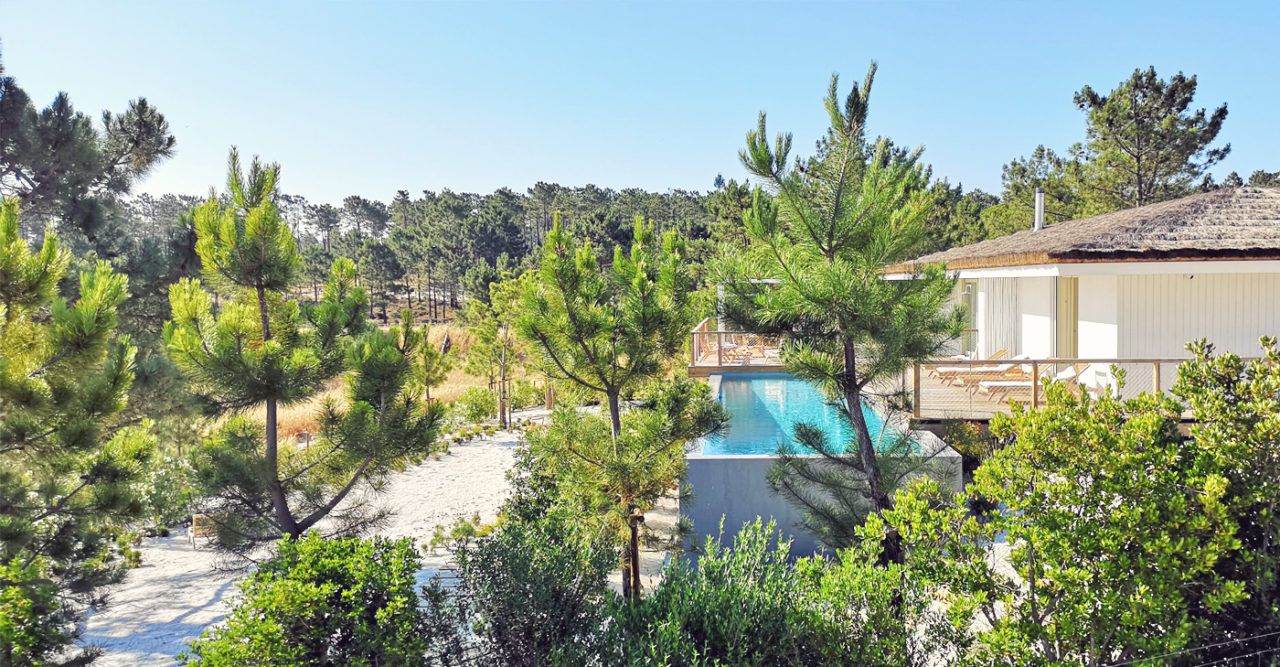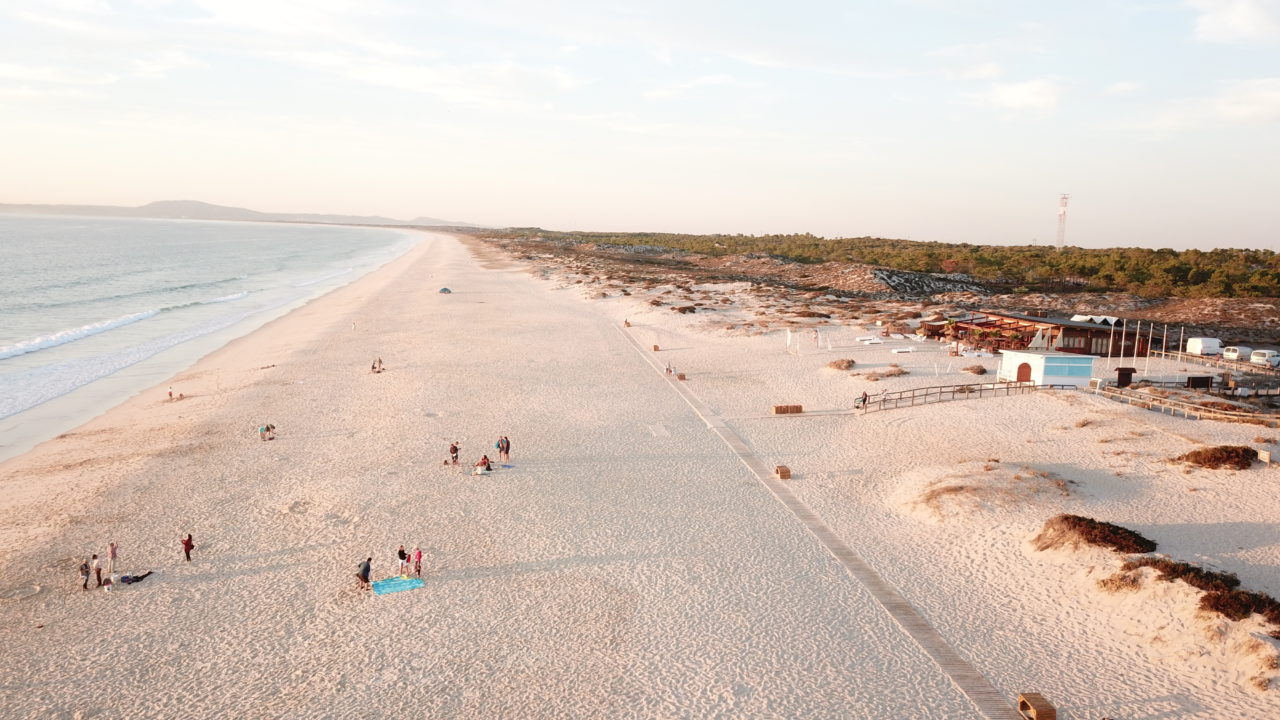

The villas of Comporta, Portugal. History and Style
Comporta, a paradise outside of time, original and unspoilt
With its patchworks of rice paddies, long untouched sandy beaches, rustic cabins and huts with thatched roofs, Comporta in Portugal is the ideal destination for those looking for peace and quiet and nature.
For many years most of the area belonged to the Espirito Santo family, one of the oldest and most important banking families in Portugal. Only a few houses, built to strict design standards, existed in this wild space.
When the family became insolvent in 2014 the Comporta estate mainly passed to the control of other bankers who opened up the area for the first time. Since then, the principal objective of Herdade da Comporta has been to develop a high quality tourist destination and become a model of sustainable development in Europe. It is of primary importance that Comporta remains an area of agriculture that preserves its unique cultural and environmental heritage.
Comporta’s style
Comporta is an area that is talked about more and more because its rare natural environment, the style of its original cabanas and the strong predilection for a “slow life” have inspired numerous architects and decorators. Christian Louboutin, Jacques Grange and Philippe Starck, for example, form part of those happy people who have been able to settle in this sought after area.
“Comporta style” is about simplicity and raw beauty and it is very much in vogue in fashion and interior decorating magazines. The cabanas and villas of Comporta are regularly featured for their unique architecture and openness to nature.
In the beginning…
At that time, the Espirito Santo family extended agricultural production over the whole 125 km2 area and built infrastructure for the community. In return the family obtained a wide band of untouched countryside, and the long, white beach that went with it, practically for their own private use. Thanks to the family’s quasi-monopoly, and the strict planning rules in the area, very few buildings were constructed and there was very little tourism. In the 90s Vera, a member of this famous family, created several new cabanas on their property, inspired by local architecture: small, independent buildings with facades made from woven reeds and lime and pointed roofs covered with palm leaves. She was the pioneer of the “Comporta style” that is so loved today and which is the inspiration behind all the new villas built in Comporta.
The interiors also had their own unique style, influenced by the environment and by local customs. Like the interiors of the cabanas of Comporta fishermen, Vera left her interiors minimalist, to the point of being bare. She decorated with Moroccan carpets, wooden furniture from Bali and printed textiles from Peru. This eccentric mix of natural raw materials and cosmopolitan but rural artefacts created “Comporta style”.
30 years ago Vera invited her friend, the architect Jacques Grange, to Comporta. He instantly fell in love with the place, with its umbrella pines and the kilometres of deserted beaches. So he bought a house in the middle of nowhere from the Espirito Santo family. In the middle of the dunes, for the first few years the cabana didn’t even have running water or electricity, the architect lived a Robinson Crusoe existence which he considered to be luxury.
The untouched beauty of Comporta began to become better known at the beginning of the 2000s. International designers and Portuguese high-society became interested in it, attracted by the region’s “tranquilidade”. They brought a breath of fresh air with them and new desires so new places began to open. Museu do Arroz, the first contemporary restaurant in the area, opened. The famous wooden beach restaurants, typical of Comporta, like the Comporta Café and Le Sal, opened on the edge of the beaches. Even today they are the only constructions allowed on the coast.
A wind of change
This development also encouraged the building of new villas by famous architects, such as Philippe Starck, Vincent van Duysen and Manuel Aires Mateus. They created extraordinary spaces for demanding clients, or for themselves. The new buildings respected the region’s architectural heritage but offered a more contemporary twist to Comporta style.
The first and most famous example is the Sublime Comporta Hotel which was designed by Portuguese architects, Miguel Câncio Martins and José Alberto Charrua. The wood and poured concrete buildings, spectacular, contemporary structures, are scattered through a magnificent pine forest and look completely at home within the surrounding natural environment.
The potential for high end tourism in the area saw the birth of new projects. In 2008 Gonçalo Pessoa commissioned architect Manuel Aires Mateus to design and construct his now famous Comporta villas called Casas Na Areia (“Houses in the Sand”). The main cabana contains the living room and the kitchen and has a floor of white sand. In this way, you actually walk on the sand that surrounds you and so feel a real connexion with nature. The idea is to encourage you slow down and make the most of the present moment.
Manuel Aires Mateus also worked on several other villas in Comporta, including Cabanas no Rio. These two little fishermen’s huts, stripped down to the essential, are situated next to the River Sado, in the nature reserve.
Comporta’s houses, cabanas and villas are created to be a unique experience, a different way of living and of understanding your environment.
This is the perspective from which our Comporta cabanas and villas were created. Our project, Espirito da Comporta, offers unique spaces, where nature is at the heart of our buildings, where people are encouraged to slow down and get connected with the unique environment that Comporta offers.
Espirito da Comporta, villas to rent in Comporta, Portugal
Our villas were designed by Portuguese architect Luis Pereira Miguel (PM-ARQ) who shares our love of Comporta and its local architecture: full of light, nestling in the surrounding nature and respecting local tradition and natural materials.
Our Comporta villas are based on local fishermen’s huts: in wood, with thatched roofs and stilts, but with modern comforts.
Authenticity and simplicity are the key words that describe Comporta and also our buildings. The interior decoration is pared back but welcoming. The idea is that everyone should naturally feel at home there.
Our cabanas are built on sand dunes and open to the nature that surrounds them. They are designed so you have endless views of the rice paddies from every room.
The gardens grow naturally from the countryside that surrounds them. The plants and flowers are carefully selected to be indigenous to the area.
Espirito da Comporta is designed to be a place that encourages peaceful contemplation, somewhere to take your time and find peace. Espirito da Comporta is three different experiences: Campo de Arroz and Flor de Arroz, facing the Carvalhal rice paddies, and Cases de Arroz, near the village of Comporta.
Campo de Arroz – a typical Comporta beach villa
With 4 bedrooms and 3 bathrooms this villa in Comporta can sleep up to 10 people, adults and children. The large living space is completely open to the deck with views of the rice paddies that stretch to the horizon.
There is a fully equipped kitchen and linen covered sofas in the living space, as well as a fire place to snuggle up to on winter evenings. Campo de Arroz is the perfect villa for holidays in Comporta in summer or in winter, as a family or with friends.
The deck is an ideal space on which to eat, read or simply relax after spending the day at the nearby beach. Alongside, the swimming pool overlooks the surrounding nature. Sun beds and armchairs encourage you to relax and enjoy the beautiful weather during the day, or admire the stars at night while sipping a glass of the best local wine.
Flor de Arroz – cabanas in the heart of the Comporta rice paddies
Two cabanas, right on the edge of the rice paddies. Live like Robinson Crusoe, in the heart of nature, admiring the spectacular change of colours as the day flows by. Enjoy the sun all day long, in the swimming pool or on the terraces.
Uniquely designed to seamlessly unite nature and contemporary architecture, in the style of the area’s fishermen’s huts. The swimming pool seems to flow out of the rice paddies. Flor de Arroz is just a few minutes from the beach and the village of Carvalhal in Comporta. The two cabanas can accommodate up to 8 people.
Casas de Arroz – An original and peaceful refuge in Comporta
Casas de Arroz is a group of four cabanas in Comporta that together create a timeless and peaceful refuge. These minimalist but comfortable villas are just a few minutes from the beach and the village of Comporta. The thatched roofs, the wood and the sand floors reflect the area’s traditional houses and hotels. The infinity pool at the end of the garden overlooks the rice paddies and fields of Comporta.
Comporta experience

Portugal in Spring – The best places
Portugal is a country with an area of 92,212 km², situated in the southwest of Europe and has around 10 million people. Because of its geographical position, it is a privileged country with a coastline of approximately 943km of Atlantic Ocean. Spring is an excellent choice for traveling to Portugal. Whatever your travel preference, we

Best time in Comporta, Portugal ?
Portugal’s climate is generally temperate, and the Atlantic influence brings a certain mildness to the country. Summers are hot and dry and the temperature is rather mild in winter for Europe, making it a popular destination for tourists all year round. The perfect time depends on what you’re looking for. There are no bad times

Christian Louboutin’s new villas
The iconic designer Christian Louboutin, world-renowned for his red-soled shoes, has brought his bold and sophisticated aesthetic to the hospitality world with the launch of his boutique hotel “Vermelho” in Melides, Portugal. The project now enters a new chapter with the addition of two villas, each with its own distinct style inspired by different design
